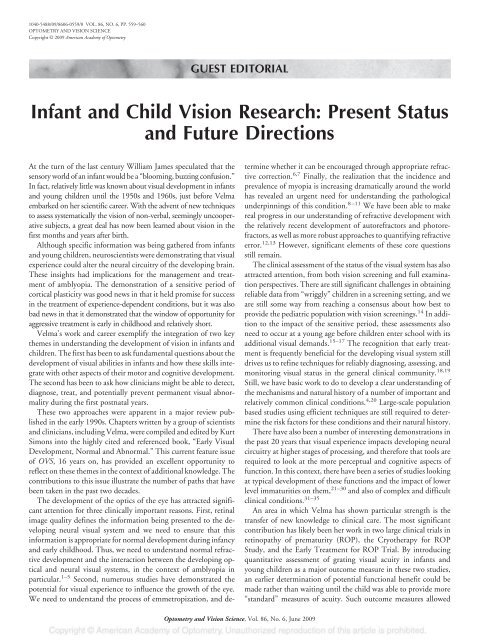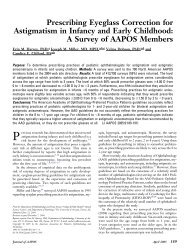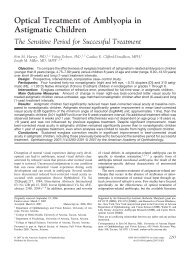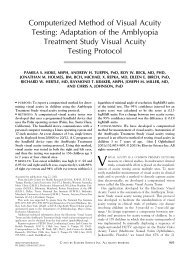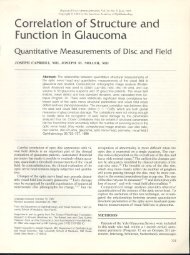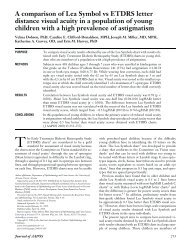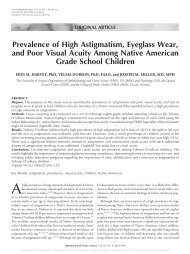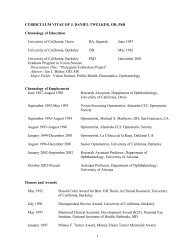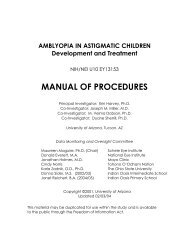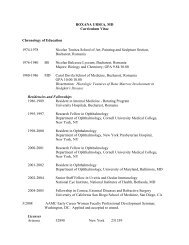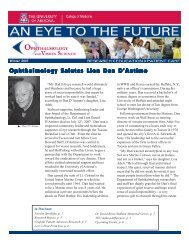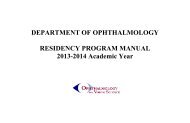Optom Vis Sci
Optom Vis Sci
Optom Vis Sci
You also want an ePaper? Increase the reach of your titles
YUMPU automatically turns print PDFs into web optimized ePapers that Google loves.
1040-5488/09/8606-0559/0 VOL. 86, NO. 6, PP. 559–560<br />
OPTOMETRY AND VISION SCIENCE<br />
Copyright © 2009 American Academy of <strong>Optom</strong>etry<br />
GUEST EDITORIAL<br />
Infant and Child <strong>Vis</strong>ion Research: Present Status<br />
and Future Directions<br />
At the turn of the last century William James speculated that the<br />
sensory world of an infant would be a “blooming, buzzing confusion.”<br />
In fact, relatively little was known about visual development in infants<br />
and young children until the 1950s and 1960s, just before Velma<br />
embarked on her scientific career. With the advent of new techniques<br />
to assess systematically the vision of non-verbal, seemingly uncooperative<br />
subjects, a great deal has now been learned about vision in the<br />
first months and years after birth.<br />
Although specific information was being gathered from infants<br />
and young children, neuroscientists were demonstrating that visual<br />
experience could alter the neural circuitry of the developing brain.<br />
These insights had implications for the management and treatment<br />
of amblyopia. The demonstration of a sensitive period of<br />
cortical plasticity was good news in that it held promise for success<br />
in the treatment of experience-dependent conditions, but it was also<br />
bad news in that it demonstrated that the window of opportunity for<br />
aggressive treatment is early in childhood and relatively short.<br />
Velma’s work and career exemplify the integration of two key<br />
themes in understanding the development of vision in infants and<br />
children. The first has been to ask fundamental questions about the<br />
development of visual abilities in infants and how these skills integrate<br />
with other aspects of their motor and cognitive development.<br />
The second has been to ask how clinicians might be able to detect,<br />
diagnose, treat, and potentially prevent permanent visual abnormality<br />
during the first postnatal years.<br />
These two approaches were apparent in a major review published<br />
in the early 1990s. Chapters written by a group of scientists<br />
and clinicians, including Velma, were compiled and edited by Kurt<br />
Simons into the highly cited and referenced book, “Early <strong>Vis</strong>ual<br />
Development, Normal and Abnormal.” This current feature issue<br />
of OVS, 16 years on, has provided an excellent opportunity to<br />
reflect on these themes in the context of additional knowledge. The<br />
contributions to this issue illustrate the number of paths that have<br />
been taken in the past two decades.<br />
The development of the optics of the eye has attracted significant<br />
attention for three clinically important reasons. First, retinal<br />
image quality defines the information being presented to the developing<br />
neural visual system and we need to ensure that this<br />
information is appropriate for normal development during infancy<br />
and early childhood. Thus, we need to understand normal refractive<br />
development and the interaction between the developing optical<br />
and neural visual systems, in the context of amblyopia in<br />
particular. 1–5 Second, numerous studies have demonstrated the<br />
potential for visual experience to influence the growth of the eye.<br />
We need to understand the process of emmetropization, and de-<br />
<strong>Optom</strong>etry and <strong>Vis</strong>ion <strong>Sci</strong>ence, Vol. 86, No. 6, June 2009<br />
termine whether it can be encouraged through appropriate refractive<br />
correction. 6,7 Finally, the realization that the incidence and<br />
prevalence of myopia is increasing dramatically around the world<br />
has revealed an urgent need for understanding the pathological<br />
underpinnings of this condition. 8–11 We have been able to make<br />
real progress in our understanding of refractive development with<br />
the relatively recent development of autorefractors and photorefractors,<br />
as well as more robust approaches to quantifying refractive<br />
error. 12,13 However, significant elements of these core questions<br />
still remain.<br />
The clinical assessment of the status of the visual system has also<br />
attracted attention, from both vision screening and full examination<br />
perspectives. There are still significant challenges in obtaining<br />
reliable data from “wriggly” children in a screening setting, and we<br />
are still some way from reaching a consensus about how best to<br />
provide the pediatric population with vision screenings. 14 In addition<br />
to the impact of the sensitive period, these assessments also<br />
need to occur at a young age before children enter school with its<br />
additional visual demands. 15–17 The recognition that early treatment<br />
is frequently beneficial for the developing visual system still<br />
drives us to refine techniques for reliably diagnosing, assessing, and<br />
monitoring visual status in the general clinical community. 18,19<br />
Still, we have basic work to do to develop a clear understanding of<br />
the mechanisms and natural history of a number of important and<br />
relatively common clinical conditions. 4,20 Large-scale population<br />
based studies using efficient techniques are still required to determine<br />
the risk factors for these conditions and their natural history.<br />
There have also been a number of interesting demonstrations in<br />
the past 20 years that visual experience impacts developing neural<br />
circuitry at higher stages of processing, and therefore that tools are<br />
required to look at the more perceptual and cognitive aspects of<br />
function. In this context, there have been a series of studies looking<br />
at typical development of these functions and the impact of lower<br />
level immaturities on them, 21–30 and also of complex and difficult<br />
clinical conditions. 31–35<br />
An area in which Velma has shown particular strength is the<br />
transfer of new knowledge to clinical care. The most significant<br />
contribution has likely been her work in two large clinical trials in<br />
retinopathy of prematurity (ROP), the Cryotherapy for ROP<br />
Study, and the Early Treatment for ROP Trial. By introducing<br />
quantitative assessment of grating visual acuity in infants and<br />
young children as a major outcome measure in these two studies,<br />
an earlier determination of potential functional benefit could be<br />
made rather than waiting until the child was able to provide more<br />
“standard” measures of acuity. Such outcome measures allowed
560 Guest Editorial<br />
intervention to be assessed in terms of functional outcome rather<br />
than simply the appearance of the ocular structure. It would not be<br />
an understatement to posit that introduction of quantitative functional<br />
measures, including those of visual acuity and visual field,<br />
revolutionized the design of clinical trials in pediatric ophthalmology<br />
and optometry and this work will have lasting benefits for our<br />
young patients. This laborious task was undertaken with intelligence,<br />
honesty, and rigor by the individual to whom this feature<br />
issue is dedicated.<br />
As we honor Velma, our mentor, colleague and friend, we trust<br />
that this compilation of research will inspire and challenge scientists<br />
to further pursuits. In particular, there is still a real need and<br />
obligation to help the families of young patients with as much<br />
prognostic information as we can develop and gather. Advancing<br />
our understanding of basic aspects of the development of extrastriate<br />
cortex, visual perception and cognition is a particularly daunting<br />
task, given the need for objective assessments in infants and<br />
young children. Hopefully, new technologies including innovative<br />
forms of brain imaging (e.g., near infrared spectroscopy, multielectrode<br />
electroencephalogram, fMRI), will allow us to develop<br />
norms and appropriate assessment tools to evaluate therapies for<br />
these complex conditions and others.<br />
REFERENCES<br />
1. Anderson HA, Glasser A, Stuebing KK, Manny RE. Minus lens stimulated<br />
accommodative lag as a function of age. <strong>Optom</strong> <strong>Vis</strong> <strong>Sci</strong> 2009;<br />
86:685–93.<br />
2. Candy TR, Wang J, Ravikumar S. Retinal image quality and postnatal<br />
visual experience during infancy. <strong>Optom</strong> <strong>Vis</strong> <strong>Sci</strong> 2009;86:566–71.<br />
3. Moseley MJ, Fielder AR, Stewart CE. The optical treatment of amblyopia.<br />
<strong>Optom</strong> <strong>Vis</strong> <strong>Sci</strong> 2009;86:629–33.<br />
4. Harvey EM. Development and treatment of astigmatism-related amblyopia.<br />
<strong>Optom</strong> <strong>Vis</strong> <strong>Sci</strong> 2009;86:634–9.<br />
5. Lewis TL, Maurer D. The effects of early pattern deprivation on<br />
visual development. <strong>Optom</strong> <strong>Vis</strong> <strong>Sci</strong> 2009;86:640–6.<br />
6. Little JA, Woodhouse M, Saunders KJ. Corneal power and astigmatism<br />
in Down Syndrome. <strong>Optom</strong> <strong>Vis</strong> <strong>Sci</strong> 2009;86:748–54.<br />
7. Mutti DO, Mitchell GL, Jones LA, Friedman NE, Frane SL, Lin<br />
WK, Moeschberger ML, Zadnik K. Accommodation, acuity, and<br />
their relationship to emmetropization in infants. <strong>Optom</strong> <strong>Vis</strong> <strong>Sci</strong><br />
2009;86:666–76.<br />
8. Gwiazda J. Treatment options for myopia. <strong>Optom</strong> <strong>Vis</strong> <strong>Sci</strong> 2009;86:<br />
624–8.<br />
9. Marsh-Tootle WL, Dong LM, Hyman L, Gwiazda J, Weise KK, Dias<br />
L, Fern KD; the COMET Group. Myopia progression in children<br />
wearing spectacles versus switching to contact lenses. <strong>Optom</strong> <strong>Vis</strong> <strong>Sci</strong><br />
2009;86:741–7.<br />
10. Schultz KE, Sinnott LT, Mutti DO, Bailey MD. Accommodative<br />
fluctuations, lens tension and ciliary body thickness. <strong>Optom</strong> <strong>Vis</strong> <strong>Sci</strong><br />
2009;86:677–84.<br />
11. Sreenivasan V, Irving EL, Bobier WR. Binocular adaptation to 2 D<br />
lenses in myopic and emmetropic children. <strong>Optom</strong> <strong>Vis</strong> <strong>Sci</strong> 2009;86:<br />
731–40.<br />
12. Howland HC. Photorefraction of eyes: history and future prospects.<br />
<strong>Optom</strong> <strong>Vis</strong> <strong>Sci</strong> 2009;86:603–6.<br />
13. Miller JM. Clinical applications of power vectors. <strong>Optom</strong> <strong>Vis</strong> <strong>Sci</strong><br />
2009;86:599–602.<br />
14. <strong>Vis</strong>ion In Preschoolers (VIP) Study Group. Findings from the <strong>Vis</strong>ion<br />
in Preschoolers (VIP) Study. <strong>Optom</strong> <strong>Vis</strong> <strong>Sci</strong> 2009;86:619–23.<br />
15. Ayton LN, Abel LA, Fricke TR, McBrien NA. The Developmental<br />
<strong>Optom</strong>etry and <strong>Vis</strong>ion <strong>Sci</strong>ence, Vol. 86, No. 6, June 2009<br />
Eye Movement Test: what is it really measuring? <strong>Optom</strong> <strong>Vis</strong> <strong>Sci</strong><br />
2009;86:722–30.<br />
16. Powers MK. Paper tools for assessing visual function. <strong>Optom</strong> <strong>Vis</strong> <strong>Sci</strong><br />
2009;86:613–8.<br />
17. Webber AL, Wood JM, Gole GA, Brown B. Effect of amblyopia on<br />
the developmental eye movement test in children. <strong>Optom</strong> <strong>Vis</strong> <strong>Sci</strong><br />
2009;86:760–6.<br />
18. Drover JR, Wyatt LM, Stager DR Sr, Birch EE. The Teller acuity<br />
cards are effective in detecting amblyopia. <strong>Optom</strong> <strong>Vis</strong> <strong>Sci</strong> 2009;86:<br />
755–9.<br />
19. Pan Y, Tarczy-Hornoch K, Cotter SA, Wen G, Borchert MS, Azen SP,<br />
Varma R; the Multi-Ethnic Pediatric Eye Disease Study (MEPEDS)<br />
Group. <strong>Vis</strong>ual acuity norms in preschool children: The Multi-Ethnic<br />
Pediatric Eye Disease Study. <strong>Optom</strong> <strong>Vis</strong> <strong>Sci</strong> 2009;86:607–12.<br />
20. Fulton AB, Hansen RM, Anne Moskowitz A. Development of rod<br />
function in term born and former preterm subjects. <strong>Optom</strong> <strong>Vis</strong> <strong>Sci</strong><br />
2009;86:653–8.<br />
21. Aslin RN. How infants view natural scenes gathered from a headmounted<br />
camera. <strong>Optom</strong> <strong>Vis</strong> <strong>Sci</strong> 2009;86:561–5.<br />
22. Bennett DM, Gordon G, Duttons GN. The Useful Field of View Test,<br />
normative data in children of school age. <strong>Optom</strong> <strong>Vis</strong> <strong>Sci</strong> 2009;86:717–21.<br />
23. Braddick OJ, Atkinson J. Infants’ sensitivity to motion and temporal<br />
change. <strong>Optom</strong> <strong>Vis</strong> <strong>Sci</strong> 2009;86:577–82.<br />
24. Brown AM, Lindsey DT. Contrast insensitivity: the critical immaturity<br />
in infant visual performance. <strong>Optom</strong> <strong>Vis</strong> <strong>Sci</strong> 2009;86:572–6.<br />
25. Dain SJ, Ling BY. Cognitive abilities of children on a grey seriation<br />
test. <strong>Optom</strong> <strong>Vis</strong> <strong>Sci</strong> 2009;86:700–6.<br />
26. Dobkins KR. Does visual modularity increase over the course of<br />
development? <strong>Optom</strong> <strong>Vis</strong> <strong>Sci</strong> 2009;86:583–8.<br />
27. García-Quispe LA, Gordon J, Zemon V. Development of contrast<br />
mechanisms in humans: a VEP study. <strong>Optom</strong> <strong>Vis</strong> <strong>Sci</strong> 2009;86:707–16.<br />
28. Held R. <strong>Vis</strong>ual-haptic mapping and the origin of crossmodal identity.<br />
<strong>Optom</strong> <strong>Vis</strong> <strong>Sci</strong> 2009;86:595–8.<br />
29. Quinn PC, Bhatt RS. Perceptual organization in infancy: bottom-up<br />
and top-down influences. <strong>Optom</strong> <strong>Vis</strong> <strong>Sci</strong> 2009;86:589–94.<br />
30. Wang YZ, Morale SE, Cousins R, Birch EE. The course of development<br />
of global hyperacuity over lifespan. <strong>Optom</strong> <strong>Vis</strong> <strong>Sci</strong> 2009;86:694–9.<br />
31. Birch EE, Jingyun Wang J. Stereoacuity outcomes following treatment<br />
of infantile and accommodative esotropia. <strong>Optom</strong> <strong>Vis</strong> <strong>Sci</strong> 2009;86:<br />
647–52.<br />
32. Agrawal S, Mayer DL, Hansen RM, Fulton AB. <strong>Vis</strong>ual fields in young<br />
children treated with vigabatrin. <strong>Optom</strong> <strong>Vis</strong> <strong>Sci</strong> 2009;86:767–73.<br />
33. Good WV. Cortical visual impairment: new directions. <strong>Optom</strong> <strong>Vis</strong><br />
<strong>Sci</strong> 2009;86:663–5.<br />
34. Summers CG. Albinism: classification, clinical characteristics, and<br />
recent findings. <strong>Optom</strong> <strong>Vis</strong> <strong>Sci</strong> 2009;86:659–62.<br />
35. Watson T, Orel-Bixler D, Haegerstrom-Portnoy G. VEP vernier,<br />
VEP grating and behavioral grating acuity in patients with cortical<br />
visual impairment. <strong>Optom</strong> <strong>Vis</strong> <strong>Sci</strong> 2009;86:774–80.<br />
Velma Dobson<br />
Tucson, Arizona<br />
T. Rowan Candy<br />
Bloomington, Indiana<br />
E. Eugenie Hartmann<br />
Birmingham, Alabama<br />
D. Luisa Mayer<br />
Boston, Massachusetts<br />
Joseph M. Miller<br />
Tucson, Arizona<br />
Graham E. Quinn<br />
Philadelphia, Pennsylvania


